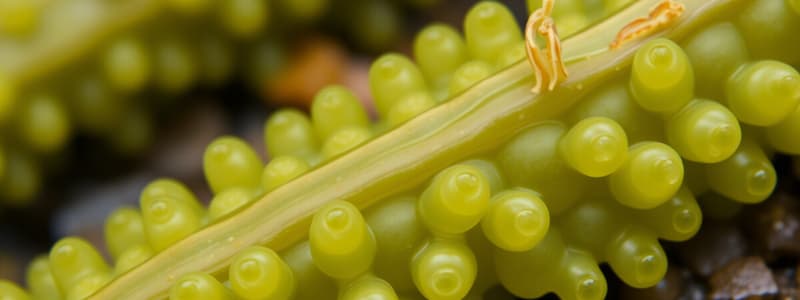Podcast
Questions and Answers
Fucus exhibits dioecious reproductive structures.
Fucus exhibits dioecious reproductive structures.
False (B)
Fungi are prokaryotic organisms that reproduce by budding.
Fungi are prokaryotic organisms that reproduce by budding.
False (B)
All fungi obtain organic compounds by absorption.
All fungi obtain organic compounds by absorption.
True (A)
The term 'fungus' refers to a singular form of fungi.
The term 'fungus' refers to a singular form of fungi.
The conceptacles in Fucus are involved in sexual reproduction.
The conceptacles in Fucus are involved in sexual reproduction.
Fungi are known to include only a few species.
Fungi are known to include only a few species.
Fucus has adaptive features that contribute to its survival.
Fucus has adaptive features that contribute to its survival.
Fungi primarily obtain their nutrients through photosynthesis.
Fungi primarily obtain their nutrients through photosynthesis.
Fucus male conceptacles are responsible for housing female gametes.
Fucus male conceptacles are responsible for housing female gametes.
Both male and female conceptacles of Fucus can be found in the same individual.
Both male and female conceptacles of Fucus can be found in the same individual.
Flashcards are hidden until you start studying
Study Notes
Fragmentation and Reproduction
- Fucus exhibits sexual reproduction through male and female conceptacles.
- Male and female structures in Fucus allow for the production of gametes.
- Monoecious nature of Fucus means both male and female reproductive organs are present in the same individual.
Adaptive Features of Fucus
- Structural adaptations enhance survival in marine environments.
Fungi Overview
- Kingdom Fungi includes thousands of eukaryotic species, characterized by spore-bearing structures.
- Mycology is the study of fungi, while fungal infections are referred to as mycoses.
- Fungi play a key role as decomposers, working alongside bacteria to break down organic materials in soils.
Reproduction in Rhizopus
- Rhizopus life cycle includes various stages of reproduction, both sexual and asexual.
Division: Ascomycetes
- Ascomycetes fungi produce spores in a sac known as an ascus.
- Common example: Penicillium roquefortii—used in blue cheese; consuming this cheese means ingesting millions of fungal spores.
Studying That Suits You
Use AI to generate personalized quizzes and flashcards to suit your learning preferences.




